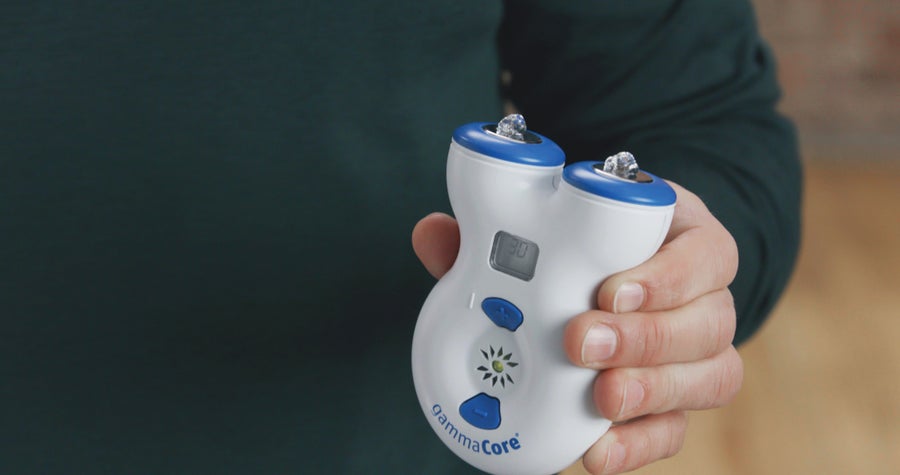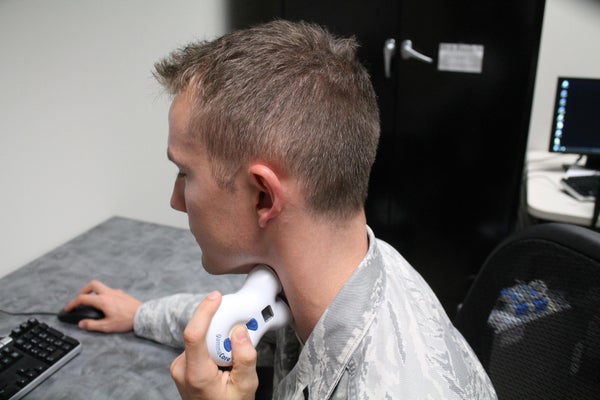Instead of reaching for a cup of coffee during a graveyard shift, workers might one day hold an electric-razor-sized device to their necks. After a couple of minutes they would emerge refreshed and awake from this experience, which could come to be known as a “vagus nerve break.”
The device, called gammaCore, sends a series of vibrating bursts of low-voltage electricity, each lasting a millisecond, to the side of the neck. It is meant to stimulate part of the vagus nerve, a connector between brain and body, and cause the release of wakefulness chemicals.
Research on a way to keep people awake and alert with electricity began after scientists affiliated and contracted with the Air Force noted that participants who had electrodes placed onto their scalps to deliver a current were able to lower fatigue and improve their performance on attention tasks. This setup is not easy to re-create outside of a lab, but if it were, it could offer an alternative to caffeine or amphetamine stimulants, also known as “go pills,” which are still prescribed to U.S. Air Force soldiers.
On supporting science journalism
If you're enjoying this article, consider supporting our award-winning journalism by subscribing. By purchasing a subscription you are helping to ensure the future of impactful stories about the discoveries and ideas shaping our world today.
Looking for a more direct and side-effect-free solution led researchers to the vagus nerve. Surgical implants that stimulate the nerve have been used to prevent seizures in people with epilepsy since 1988, and some of these patients have found that the implant helped them manage their headaches and pain. Other studies have found that implanted vagus nerve stimulation improved memory and cognition in both humans and animals.
New research provides confirmation that handheld vagus nerve stimulation does what scientists thought it might: gammaCore helped members of the Air Force perform better and feel less fatigued when pulling an all-nighter. Results from the study were published today in the journal Communications Biology.

GammaCore device. Credit: electroCore
Many thought stimulating the vagus nerve without needles or surgery was impossible before the technology was invented a decade ago, says Peter Staats, chief medical officer and co-founder of electroCore, the company that makes gammaCore. The handheld device works by touching conductive gel on the skin’s surface, and it was first approved to treat cluster headaches in adults in 2017. Since then, its use has been expanded to include adult and adolescent migraines, and it has received emergency use authorization for asthma worsened by COVID-19 in adults. The device iscovered by several major pharmacy benefit managers when it is prescribed,and its list price is $1,750, though the company says it has been offering gammaCore to all customers for $1,250 for now. (An electroCore spokesperson notes the newest model can cost as low as $399 for three months of treatment.)
Vagus nerve stimulation is a popular target for bioelectronic medicine because of the direct links between the nerve and many of the body’s organs. Stephen Silberstein, a neurology professor at Thomas Jefferson University and director of the Jefferson Headache Center, compares the vagus nerve to a major transportation hub such as Grand Central Terminal in New York City, where hopping on a train or subway can send a commuter anywhere in the metropolitan area. Similarly, different types of fibers travel to different places, including a part of the brain called the locus coeruleus. There, the brain produces norepinephrine, a fight-or-flight chemical that increases alertness and decreases pain and tiredness.
In the study, researchers observed 40 active-duty soldiers from an Air Force base as they stayed awake for 34 hours, during which time they completed cognitive tests and reported their mood and level of fatigue. Half of the participants used gammaCore for eight minutes near the beginning of testing, while the other half were given a sham device that looked and felt like the real deal but did not provide an electrical current. Those in the group that received the real vagus nerve stimulation stuck more closely to their baseline performance as the night wore on and reported less fatigue over time than the other group.
“It’s exciting to us that not only do they perform better, but they also perceive that they’re performing better and that they feel less tired,” says Richard McKinley, a co-author of the study and a biomedical engineer at the Air Force Research Laboratory. He says that improvements in mood and energy level could motivate the soldiers to use a device like this outside of a paid study.
While the two groups performed similarly over time on some portions of the cognitive testing, hours later, the participants who used gammaCore showed less performance decline in perception-related tasks—taking in and synthesizing audio, visual or other kinds of information.
Past research on gammaCore and vagus nerve stimulation has targeted populations with chronic and often debilitating conditions such as rheumatoid arthritis, migraine headaches and epilepsy. This new work is leading the charge to use this therapy on healthy people for performance enhancement, Staats and the study’s authors say.
“Much of what we do in Western medicine is: we try to help people who have already got diseases,” Staats says. “We spend less effort thinking about health regimens or ‘How do we avoid development of diseases?’ or ‘How do we optimize ourselves?’”
Silberstein, who was not involved in the study, says this device could help a wide range of sleep-deprived individuals, from Air Force pilots to doctors to college students writing last-minute papers.
Another group that might benefit from the research is astronauts. Lindsey McIntire, the paper’s first author and a scientist at the defense-contracted company Infoscitex, says that NASA provided some of the study’s funding because astronauts often sleep in extreme and unfamiliar environments, leading to less restful slumber. Finding a long-lasting solution to fatigue would keep people happier, healthier and more focused on their tasks in space.
Eric Chang, an assistant professor at the Feinstein Institutes for Medical Research, who was also not involved in the research, says its findings may not be generalizable to people who are not continuously sleep-deprived for 34 straight hours, as the participants were. He adds that the study reports a “specific, small result” that is in line with other vagus-nerve-stimulation studies.
McIntire notes that differences in performance between the gammaCore and placebo groups that may appear small—such as in the multitasking test—can have big implications. “Performance for the active group declined 5 percent, but it declined to 15 percent for [the placebo group],” she says. “That’s mistakes, and in certain fields like medicine and the military and transportation, that can equal lives.” The authors are also planning research to examine effects in people with milder sleep deprivation.
McIntire says future studies need to be done before gammaCore can be recommended to soldiers and workers for off-label use, including testing it against caffeine and other conventional stimulants. McKinley adds that concurrent studies in animals are double-checking the effect’s mechanism, and he is also preparing to submit research on vagus nerve stimulation to boost learning rates and retention.
GammaCore owes its invention to the relatively new field of bioelectric medicine, a discipline that uses electricity to hack into the body’s signaling system to treat disease. Bioelectronic medicine has shown promise in treating autoimmune diseases such as lupus through vagus nerve stimulation. Tiredness, pain, inflammation—future “vagus nerve breaks” could target them all.
